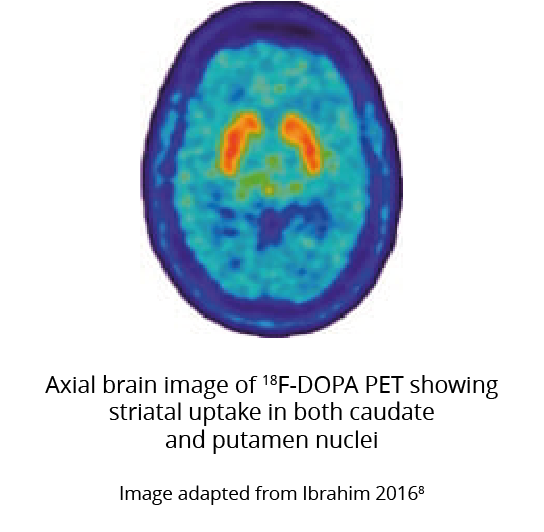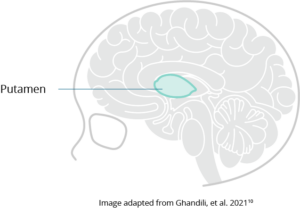What is AADC deficiency?
Aromatic L-amino acid decarboxylase (AADC) deficiency is a rare, inherited neurotransmitter disorder and a lifelong condition.1 Neurotransmitters, such as dopamine, are responsible for important signalling in the central nervous system.2 Neurotransmitters regulate a variety of bodily functions such as movement, cognition and emotion.2 The combined severe deficiency of the neurotransmitters, serotonin, dopamine, epinephrine and norepinephrine results in severe motor and developmental delay, autonomic dysfunction and increased risk of premature death.1,3
The defects in neurotransmitter synthesis in AADC deficiency can lead to the manifestation of a broad spectrum of symptoms.1
The most common symptoms of AADC deficiency are:1
- Hypotonia
- Developmental delay
- Movement disorders, especially oculogyric crisis
Symptoms of AADC deficiency can appear in infancy as early as 2.7 months, but despite this early age of symptom onset, mean age of diagnosis is 3.5 years.1
The signs and symptoms of AADC deficiency have considerable overlap with those seen in other neurological disorders: as a result, diagnosis can be challenging.2
Some of these conditions include:2
- Cerebral palsy
- Epilepsy
- Juvenile parkinsonism
What is the biochemical basis of AADC deficiency?
AADC deficiency is an autosomal recessive genetic disease.2 Mutations in the dopa decarboxylase (DDC) gene result in impaired activity of the AADC enzyme.2 AADC is involved in the production of several neurotransmitters – notably dopamine, serotonin, adrenaline and noradrenaline – the production of which is decreased in patients with AADC deficiency.2
Reductions in neurotransmitter activity are associated with an increase in metabolite concentrations of levodopa (L-Dopa), 3-O-Methyldopa (3-OMD) and 5-hydroxytryptophan (5-HTP), and a decrease in homovanillic acid (HVA) and 5-hydroxyindoleacetic acid (5-HIAA) concentrations.2
The severe combined imbalance of these metabolites in AADC deficiency causes the somatic and autonomic symptoms associated with the condition.2

Adapted from Wassenberg 2017.1
3-OMD, 3-O-methyldopa; 5-HIAA, 5-hydroxyindoleacetic acid; 5-HTP, 5-hydroxytryptophan; HVA, homovanillic acid; L-dopa, L-3,4-dihydroxyphenylalanine; VLA, vanillactic acid.
What is the role of the putamen in AADC deficiency?
 The putamen plays a key role in development including learning and motor control, speech and language functions, and cognitive ability.5 It is a major site of AADC enzyme activity in the brain.6
The putamen plays a key role in development including learning and motor control, speech and language functions, and cognitive ability.5 It is a major site of AADC enzyme activity in the brain.6
AADC is an essential enzyme required for synthesizing dopamine, and mutations in the DDC gene cause the profound loss of dopamine in the putamen.7
Without neuronal dopamine, patients suffer from movement disorders including hypokinesia, dystonia, and oculogyric crisis that result in motor dysfunction, along with behavioural problems, autonomic dysfunction, and developmental delay.9

Patients with this rare condition can easily be misdiagnosed.
Use the resources on this site to help to ensure that patients with AADC deficiency receive a timely, accurate diagnosis.
Find out about overlapping symptoms
REGISTER HERE for access to exclusive expert-led educational content
- Wassenberg T, et al. Orphanet J Rare Dis. 2017;12:12.
- Ng J, et al. Pediatr Drugs. 2014.
- Chen PW, et al. Clin Chem Acta. 2014;431:19–22.
- Kurian MA, Abela L. DNAJC6 Parkinson Disease. 2021 May 13. In: Adam MP, et al., editors. GeneReviews® [Internet]. Seattle (WA): University of Washington, Seattle; 1993–2022. Available from: https://www.ncbi.nlm.nih.gov/books/NBK570369/.
- Ghandili M, Munakomi S. Neuroanatomy, Putamen. In: StatPearls [Internet] Treasure Island (FL): StatPearls Publishing; 2022. Available from: https://www.ncbi.nlm.nih.gov/books/NBK542170/.
- Helman G, et al. JIMD Rep. 2014;17:23–27.
- Onuki Y, et al. Brain Commun. 2021;3:fcab078.
- Ibrahim N, et al. Am J Nuc Med Mol Imaging. 2016;6(1):102-109
- Tai CH, et al. Mol Ther. 2022;30:509–518.
- Ghandili M, et al. NCBI Bookshelf. 2021
